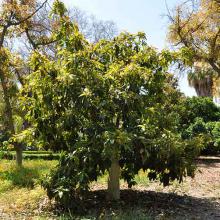Persea americana
Common name:
Avocado
Genus:
Persea
Family:
Lauraceae
Order:
Laurales
Persea americana
Common name:
Avocado
Genus:
Persea
Family:
Lauraceae
Order:
Laurales
Persea americana
Common name:
Avocado
Genus:
Persea
Family:
Lauraceae
Order:
Laurales
Family (Plantae): Lauraceae
The flowering plant family Lauraceae, the laurels, includes the true laurel and its closest relatives. This family comprises about 2850 known species in about 45 genera worldwide (Christenhusz & Byng 2016 [2]). They are dicotyledons, and occur mainly in warm temperate and tropical regions, especially Southeast Asia and South America. Many are aromatic evergreen trees or shrubs, but some, such as Sassafras, are deciduous, or include both deciduous and evergreen trees and shrubs, especially in tropical and temperate climates. The genus Cassytha is unique in the Lauraceae in that its members are parasitic vines.
Overview
The family has a worldwide distribution in tropical and warm climates. The Lauraceae are important components of tropical forests ranging from low-lying to montane. In several forested regions, Lauraceae are among the top five families in terms of the number of species present.
The Lauraceae give their name to habitats known as laurel forests, which have many trees that superficially resemble the Lauraceae, though they may belong to other plant families such as Magnoliaceae or Myrtaceae. Laurel forests of various types occur on most continents and on many major islands.
Although the taxonomy of the Lauraceae is still not settled, conservative estimates suggest some 52 genera worldwide, including 3,000 to 3,500 species. Compared to other plant families, the taxonomy of Lauraceae still is poorly understood. This is partly due to its great diversity, the difficulty of identifying the species, and partly because of inadequate investment in taxonomic work.
Recent monographs on small and medium-sized genera of Lauraceae (up to about 100 species) have revealed many new species. Similar increases in the numbers of species recognized in other larger genera are to be expected.
Description
Most of the Lauraceae are evergreen trees in habit. Exceptions include some two dozen species of Cassytha, all of which are obligately parasitic vines.
The fruits of Lauraceae are drupes, one-seeded fleshy fruit with a hard layer, the endocarp, surrounding the seed. However, the endocarp is very thin, so the fruit resemble a one-seeded berry. The fruit in some species (particularly in the genera Ocotea and Oreodaphne) are partly immersed or covered in a cup-shaped or deep thick cupule, which is formed from the tube of the calyx where the peduncle joins the fruit; this gives the fruit an appearance similar to an acorn. In some Lindera species, the fruit have a hypocarpium at the base of the fruit.
Distribution and uses
Because the family is so ancient and was so widely distributed on the Gondwana supercontinent, modern species commonly occur in relict populations isolated by geographical barriers, for instance on islands or tropical mountains. Relict forests retain endemic fauna and flora in communities of great value in inferring the palaeontological succession and climate change that followed the breakups of the supercontinents.
- Many Lauraceae contain high concentrations of essential oils, some of which are valued for spices and perfumes. Within the plants, most such substances are components of irritant or toxic sap or tissues that repel or poison many herbivorous or parasitic organisms.
- Some of the essential oils are valued as fragrances, such as in the traditional laurel wreath of classical antiquity, or in cabinet making, where the fragrant woods are prized for making insect-repellant furniture chests.
- Some are valued in cooking, for example, bay leaves are a popular ingredient in European, American, and Asian cuisines.
- Avocados are important oil-rich fruit that are cultivated in warm climates around the world.
- Many species are exploited for timber.
- Some species are valued as sources of medicinal material.
These genera include some of the best-known species of particular commercial value:
- Cinnamomum: cinnamon, cassia and camphor laurel
- Laurus: bay laurel
- Persea: avocado
Loss of habitat and overexploitation for such products has put many species in danger of extinction as a result of overcutting, extensive illegal logging, and habitat conversion.
Conversely, some species, though commercially valuable in some countries, are regarded as aggressive invaders in other regions. For example, Cinnamomum camphora, though a valued ornamental and medicinal plant, is so invasive as to have been declared a weed in subtropical forested areas of South Africa.
Reference: Wikipedia

